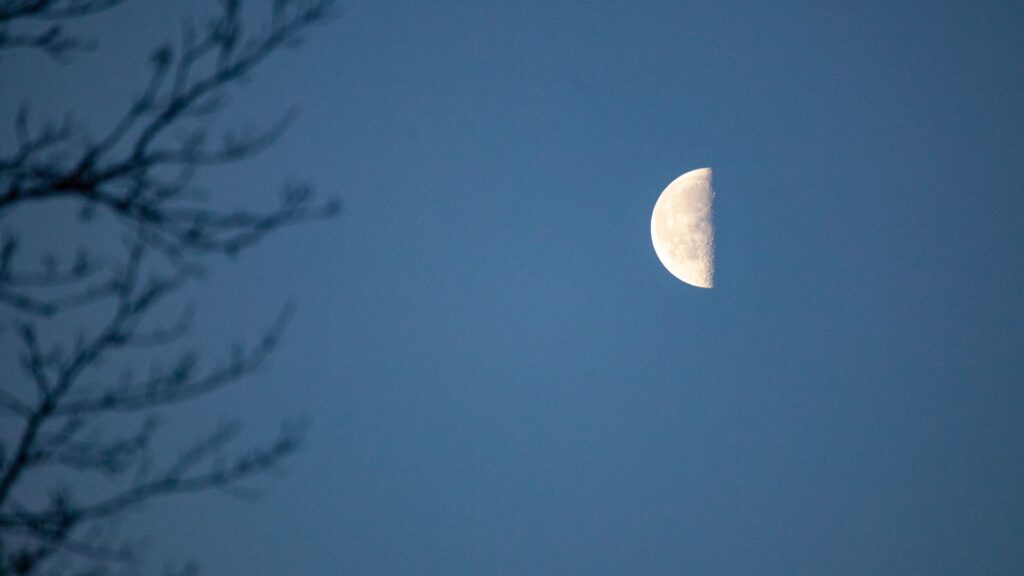The new year begins with beautiful astronomical phenomena to admire. Shooting stars, conjunctions, maximum elongation of Mercury… Discover the program for January 2024.
2023 ends, a page turns. It’s time to discover the astronomical shows that the year 2024 has in store for us. And, if you are tired of good resolutions abandoned on January 2, this guide should motivate you. It only contains phenomena that are easy to see, even without a telescope, until the end of January.
Here are the astronomical events to admire to start the year off right, accessible to all beginner astronomers.
The phases of the Moon
Whether you are outside, well protected by a big coat, or warm behind a window, the Moon is one of the most accessible astronomical spectacles. Here are its phases during the month of January, to help you get your bearings.
- THE Thursday January 4, this is the half-quarter phase. Look up to see the western half of the Moon, illuminated by the Sun.
- THE Thursday January 11 corresponds to the new Moon. It is impossible to see the Moon in the sky, because it is in conjunction with the Sun at this time.
- THE Thursday January 18, we find a half Moon, in the first quarter phase this time. It is therefore its eastern half that we can observe.
- THE Thursday January 25, the full Moon is back. This name is given to the moment when the Moon is in opposition to the Sun.

Planets visible to the naked eye
Mars shines… by its absence in the sky this month. On the other hand, Mercury, Venus, Jupiter and Saturn are clearly observable during January nights, with the naked eye. Here is which constellations to look for them in and at what times.
| Mercury | Venus | Jupiter | Saturn | |
|---|---|---|---|---|
| From 1st to 7 | 7:20 a.m. – 8:20 a.m. Ophiuchus | 6:10 a.m. – 8:40 a.m. Scorpio | 5 p.m. – 2:50 a.m. Ram | 5:20 p.m. – 8:50 p.m. Aquarius |
| From 8 to 14 | 7:20 a.m. – 8:20 a.m. Sagittarius | 6:30 a.m. – 8:40 a.m. Ophiuchus | 5:10 p.m. – 2:20 a.m. Ram | 5:20 p.m. – 8:30 p.m. Aquarius |
| From 15 to 21 | 7:30 a.m. – 8:20 a.m. Sagittarius | 6:40 a.m. – 8:30 a.m. Ophiuchus | 5:20 p.m. – 1:50 a.m. Ram | 5:30 p.m. – 8 p.m. Aquarius |
| From 22 to 28 | 7:50 a.m. – 8:10 a.m. Sagittarius | 7 a.m. – 8:20 a.m. Sagittarius | 5:30 p.m. – 1:30 a.m. Ram | 5:40 p.m. – 7:40 p.m. Aquarius |
| From 29 to 31 | invisible | 7 a.m. – 8:20 a.m. Sagittarius | 5:40 p.m. – 1:10 a.m. Ram | 6 p.m. – 7:20 p.m. Aquarius |
Other astronomical phenomena
And, here are all the other astronomical phenomena to observe in January 2024 (beginner level):
- THE Wednesday January 3, the Earth is at perihelion, that is to say its distance from the Sun is minimal. There is nothing unusual to observe, however one may wonder: if the Earth is closer to the Sun in winter, why is it colder?
- THE Thursday January 4it is the maximum of the Quadrantid shooting star swarm.
- THE Monday January 8it’s time to observe a lovely conjunction between the Moon, Venus, Mercury and the star Antares.
- THE Tuesday January 9the conjunction is still visible, the Moon has simply moved compared to the day before.
- THE Friday January 12this is the maximum elongation of Mercury (in the morning).
- THE Saturday January 13admire the ashen light.
- THE Sunday January 14a beautiful duo between the Moon and Saturn is to be contemplated.
- THE Thursday January 18, the first quarter Moon is very close to Jupiter. Take out the binoculars to see how they get closer!
You are now ready to scan the sky to get the year 2024 off to a good start. Happy observing (and happy new year)!
If you liked this article, you will like the following: don’t miss them by subscribing to Numerama on Google News.
